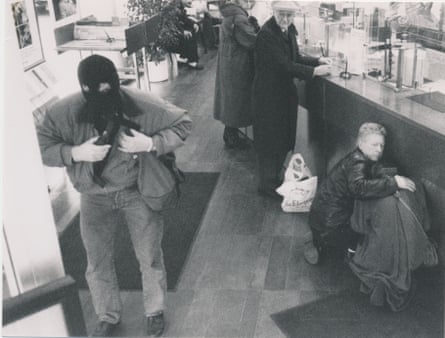A Swedish far-right extremist whose shooting spree in the 1990s inspired “lone wolf” terrorists such as Anders Breivik will go on trial in Germany on Wednesday morning for an unresolved murder of an Auschwitz survivor in Frankfurt 25 years ago.
John Ausonius, 64, is already serving a life sentence in Sweden for the shooting of 11 people of immigrant background in the Stockholm and Uppsala area between August 1991 and January 1992. His aim, he said in interviews, was to scare immigrants out of the country and discourages others from entering.
Ausonius was dubbed Lasermannen, or “laser man”, in Swedish media because he used a rifle equipped with laser sight for the attacks, which left Jimmy Ranjbar, an Iranian student, dead and others with severe disabilities.
Now, 17 years after eventually confessing to 10 attempted shootings, Ausonius will appear in a Frankfurt court for a trial that could dash his hopes of an early release.
On 8 February 1992, while on the run from Swedish police, Ausonius visited a restaurant in the city’s Opernplatz square. Two weeks later he returned, accusing cloakroom attendant Blanka Zmigrod of having stolen an electronic Casio notebook from his pocket.
An altercation ended with Ausonius shouting “we will meet again” at Zmigrod as he left the restaurant. The following night, the 68-year-old was shot from close range by a hooded cyclist as she walked home from work.
A new documentary, published on Wednesday by Aftonbladet newspaper, reveals for the first time that Zmigrod had been a prisoner at four concentration camps, including Auschwitz and Bergen-Belsen, and survived several of the infamous “death marches”.
After the war, she met fellow Holocaust survivor Sacha Feldman in Tel Aviv, and in 1960 the couple later moved back to Germany to run restaurants and hotels.Swedish police investigator Stefan Bergquist has said Ausonius smiled and appeared happy when informed during questioning in 1993 that Zmigrod had Jewish ancestry.
Ausonius has confirmed that he used to possess the same type of Browning pistol and ammunition used in the murder, but denies shooting Zmigrod. His lawyer, Joachim Bremer, said there were “isolated leads, but no self-sustaining chain [of evidence]” which proved Ausonius was responsible for the death.
The case in Frankfurt has been reopened partly because of speculation that the “laser man” shootings served as a blueprint for killings carried out between 2000 and 2007 by German neo-Nazi terrorist group National Socialist Underground (NSU).
Like Ausonius, members of the NSU shot their targets from close range and carried out bank robberies to fund their terrorism campaign, often escaping on bikes. In both cases, the terrorists did not claim responsibility for their actions at the time, leading investigators to initially suspect the shootings were gang-related.

According to Mattias Gardell, a professor at Uppsala University, Ausonius was the first white nationalist in Europe to adopt a “lone wolf” tactic of militant action, operating under the radar in order to avoid being detected and stopped by authorities.
“Ausonius was in favour of more visible rightwing movements in Sweden,” said Gellert Tamas, a Swedish journalist whose book Lasermannen became an international bestseller. “But he deliberately didn’t join them, knowing that such networks would be the first place where police would look for him.”
Norwegian white supremacist Anders Breivik, who killed 77 people in a terrorist attack in Oslo and the island of Utøya in July 2011, directly cited the “laser man” as the inspiration for his killing spree in a court statement, though it remains unclear whether he was referring to Ausonius or another Swedish copycat killer, Peter Mangs.
After he complained against what he perceived to be a campaign of “terror” against opponents of multiculturalism, Breivik said in court: “It is these injustices that created me, and Laserman in Sweden.”
Ausonius has said he was inspired to carry out his crimes by the rise of new Swedish far-right parties such as New Democracy and Sweden Democrats, but interviews also hint at a deeper psychological motive.
Born Wolfgang Zaugg to a Swiss father and a German mother, the man who sought out immigrant victims, had an immigrant background himself. Thanks to his black hair and brown eyes, he was ostracised at school and bullied.
Only in his 20s did he obtain Swedish citizenship and change his name to Ausonius, after a Roman poet. He also tried to dye his hair blond and wore blue contact lenses to change his eye colour. “His whole life was about proving himself to be a real Swede,” said Tamas, who interviewed Ausonius 10 times between 2000 and 2001.
Frankfurt’s public prosecutor has scheduled seven court dates between Wednesday and 21 January. Ausonius will be returned to prison in Sweden at the end of the trial whether he is found guilty or not.
In the last nine years he has applied four times for an early release. A conviction in Germany would make it even less likely that his appeals will be successful in the future.
